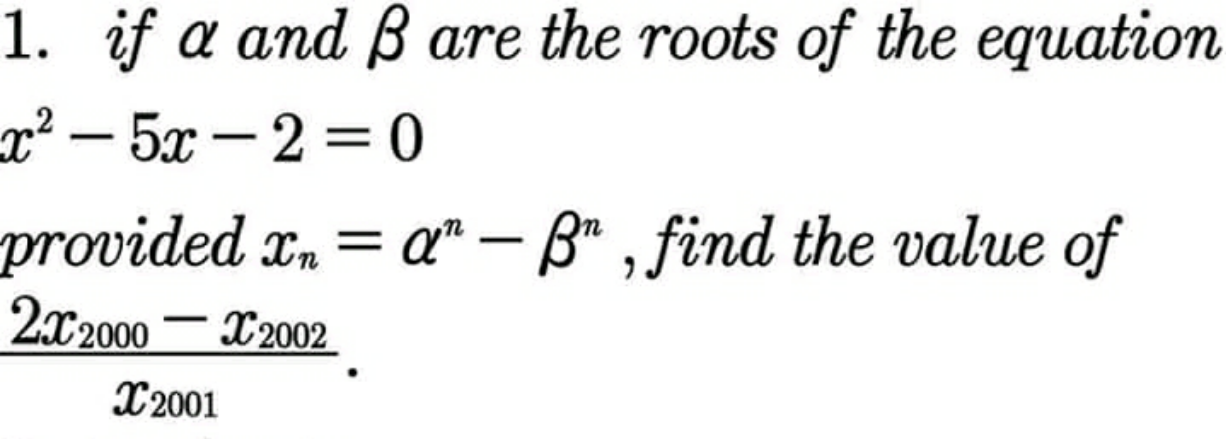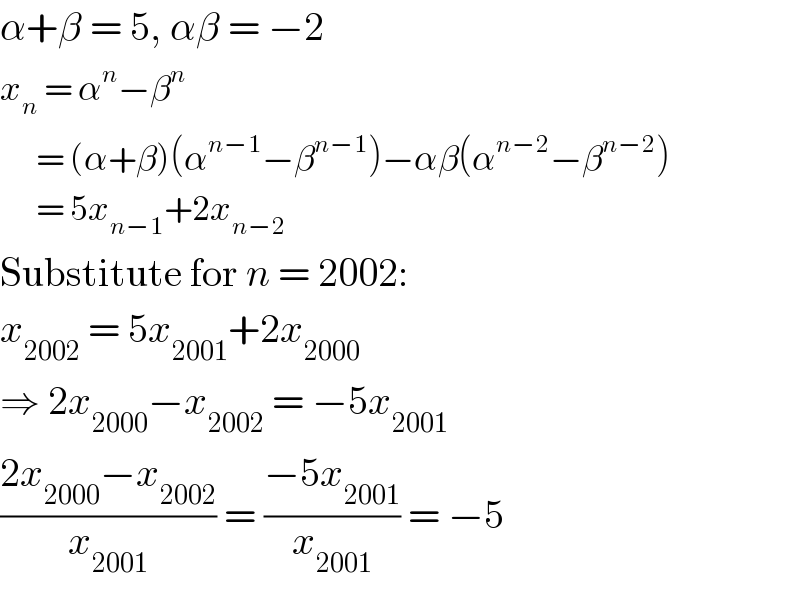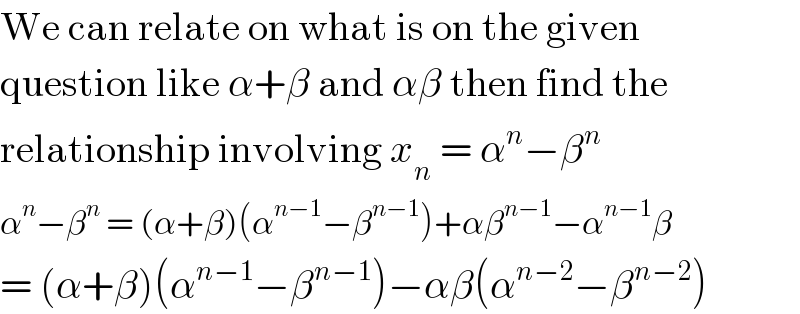Question Number 105536 by I want to learn more last updated on 29/Jul/20

Answered by adhigenz last updated on 29/Jul/20

$$\alpha+\beta\:=\:\mathrm{5},\:\alpha\beta\:=\:−\mathrm{2} \\ $$$${x}_{{n}} \:=\:\alpha^{{n}} −\beta^{{n}} \\ $$$$\:\:\:\:\:\:=\:\left(\alpha+\beta\right)\left(\alpha^{{n}−\mathrm{1}} −\beta^{{n}−\mathrm{1}} \right)−\alpha\beta\left(\alpha^{{n}−\mathrm{2}} −\beta^{{n}−\mathrm{2}} \right) \\ $$$$\:\:\:\:\:\:=\:\mathrm{5}{x}_{{n}−\mathrm{1}} +\mathrm{2}{x}_{{n}−\mathrm{2}} \\ $$$$\mathrm{Substitute}\:\mathrm{for}\:{n}\:=\:\mathrm{2002}: \\ $$$${x}_{\mathrm{2002}} \:=\:\mathrm{5}{x}_{\mathrm{2001}} +\mathrm{2}{x}_{\mathrm{2000}} \\ $$$$\Rightarrow\:\mathrm{2}{x}_{\mathrm{2000}} −{x}_{\mathrm{2002}} \:=\:−\mathrm{5}{x}_{\mathrm{2001}} \\ $$$$\frac{\mathrm{2}{x}_{\mathrm{2000}} −{x}_{\mathrm{2002}} }{{x}_{\mathrm{2001}} }\:=\:\frac{−\mathrm{5}{x}_{\mathrm{2001}} }{{x}_{\mathrm{2001}} }\:=\:−\mathrm{5} \\ $$
Commented by I want to learn more last updated on 29/Jul/20

$$\mathrm{Wow},\:\mathrm{thanks}\:\mathrm{sir},\:\mathrm{but}\:\mathrm{how}\:\mathrm{do}\:\mathrm{we}\:\mathrm{know}\:\mathrm{where}\:\mathrm{to}\:\mathrm{stop}\:\mathrm{in}\:\mathrm{the}\:\mathrm{expansion}\:\mathrm{of} \\ $$$$\:\:\alpha^{\mathrm{n}} \:\:−\:\:\beta^{\mathrm{n}} \:\:\:\mathrm{and}\:\mathrm{how}\:\mathrm{we}\:\mathrm{get}\:\mathrm{the}\:\mathrm{expansion}. \\ $$
Commented by adhigenz last updated on 30/Jul/20

$$\mathrm{We}\:\mathrm{can}\:\mathrm{relate}\:\mathrm{on}\:\mathrm{what}\:\mathrm{is}\:\mathrm{on}\:\mathrm{the}\:\mathrm{given} \\ $$$$\mathrm{question}\:\mathrm{like}\:\alpha+\beta\:\mathrm{and}\:\alpha\beta\:\mathrm{then}\:\mathrm{find}\:\mathrm{the} \\ $$$$\mathrm{relationship}\:\mathrm{involving}\:{x}_{{n}} \:=\:\alpha^{{n}} −\beta^{{n}} \\ $$$$\alpha^{{n}} −\beta^{{n}} \:=\:\left(\alpha+\beta\right)\left(\alpha^{{n}−\mathrm{1}} −\beta^{{n}−\mathrm{1}} \right)+\alpha\beta^{{n}−\mathrm{1}} −\alpha^{{n}−\mathrm{1}} \beta \\ $$$$=\:\left(\alpha+\beta\right)\left(\alpha^{{n}−\mathrm{1}} −\beta^{{n}−\mathrm{1}} \right)−\alpha\beta\left(\alpha^{{n}−\mathrm{2}} −\beta^{{n}−\mathrm{2}} \right) \\ $$
Commented by I want to learn more last updated on 30/Jul/20

$$\mathrm{I}\:\mathrm{appreciate}\:\mathrm{sir} \\ $$
